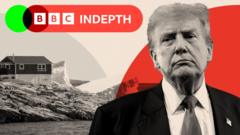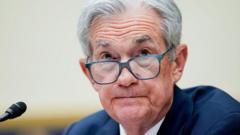Greenland, a self-governing territory of Denmark, grapples with its colonial past and the prospect of a future independent from Danish influence, while conflicting sentiments emerge about greater ties with the U.S. and other nations.
Greenland's Quest for Identity and Independence in the Shadow of U.S. Interests

Greenland's Quest for Identity and Independence in the Shadow of U.S. Interests
Amid increasing international attention from figures like Donald Trump, Greenland faces a complex relationship with both Denmark and potential new alliances.
Article Text:
On a hill overlooking Nuuk's cathedral, a statue of the 17th-century Protestant missionary Hans Egede stands prominently. Egede is credited with reconnecting Greenland to Northern Europe, laying the foundation for Denmark's colonization that has significantly shaped the territory's trajectory. Decades ago, anger over colonial impacts led to this statue being doused in red paint—a symbolic protest against the historical changes ushered in by Egede.
Having lived in Greenland during my childhood, I observed firsthand the struggles of the Inuit population. Amid the benefits of modern healthcare and education, issues like pervasive alcoholism emerged as profound challenges linked to the historical imposition by Denmark. The transition from Godthaab to Nuuk in the late 1970s embodied a slow yearning for recognition and independence that has persisted over the decades.
Today, Greenland—home to 57,000 people—finds itself at a pivotal juncture, especially in light of Donald Trump’s recent interest in acquiring the territory. When asked about utilizing military or economic force to claim Greenland, Trump’s ambiguous response left many questioning the true desires of the island's residents. Subsequently, he declared that Greenlanders “want to be with us,” igniting skepticism among locals regarding the actual sentiment toward potential U.S. control.
Danish Prime Minister Mette Frederiksen has made it clear that Greenland is not for sale; her stance emphasizes that the territory’s future lies in the hands of its people. Polling indicates that 85% of Greenlanders oppose the idea of joining the U.S., and only a mere 6% favor it. Such sentiments are fueled by a history of colonial injustices, highlighted by the recent acknowledgment of oppressive contraceptive campaigns and the forced removal of children to Denmark—actions described by Greenland's Prime Minister as a form of genocide.
As discussions of independence grow louder, it's crucial to examine the desires shaping this movement. Opinion surveys consistently indicate that roughly two-thirds of Greenlanders support full independence. Yet, the path to sovereignty is fraught with complexities. The intertwined nature of political and economic independence raises concerns, as a significant portion of Greenland's economy relies on Danish subsidies—financial support that would likely dwindle in the event of independence.
Further complicating matters are the stakes of social welfare—a key factor in Greenland's longstanding relationship with Denmark. Many Greenlanders express a desire for independence, yet they wish to preserve their robust healthcare and social benefits, underscoring a fear of losing essential support systems.
While examining Greenland's options, the prospect of forming closer ties with nations like Canada and Iceland emerges prominently. For many, the cultural and geographical commonalities shared with these nations feel more authentic than those with Denmark. However, persistent concerns about whether these nations would be willing to take on the responsibility of safeguarding Greenland's social welfare looms large.
In this dynamic space, Trump’s overtures add urgency to ongoing discussions about national identity and autonomy. Some Greenlanders are re-evaluating their initial openness to U.S. ties, reflecting a growing skepticism—fueled by the painful legacy of colonial rule adjacent to aspirations for rightful self-determination.
The future of Greenland teeters between possibilities, revealing a landscape both vibrant with opportunity and constrained by history. The decisions that lie ahead, driven by the aspirations of its people, will shape the narrative of an island still wrestling with its past, identity, and place in a rapidly evolving global context.
On a hill overlooking Nuuk's cathedral, a statue of the 17th-century Protestant missionary Hans Egede stands prominently. Egede is credited with reconnecting Greenland to Northern Europe, laying the foundation for Denmark's colonization that has significantly shaped the territory's trajectory. Decades ago, anger over colonial impacts led to this statue being doused in red paint—a symbolic protest against the historical changes ushered in by Egede.
Having lived in Greenland during my childhood, I observed firsthand the struggles of the Inuit population. Amid the benefits of modern healthcare and education, issues like pervasive alcoholism emerged as profound challenges linked to the historical imposition by Denmark. The transition from Godthaab to Nuuk in the late 1970s embodied a slow yearning for recognition and independence that has persisted over the decades.
Today, Greenland—home to 57,000 people—finds itself at a pivotal juncture, especially in light of Donald Trump’s recent interest in acquiring the territory. When asked about utilizing military or economic force to claim Greenland, Trump’s ambiguous response left many questioning the true desires of the island's residents. Subsequently, he declared that Greenlanders “want to be with us,” igniting skepticism among locals regarding the actual sentiment toward potential U.S. control.
Danish Prime Minister Mette Frederiksen has made it clear that Greenland is not for sale; her stance emphasizes that the territory’s future lies in the hands of its people. Polling indicates that 85% of Greenlanders oppose the idea of joining the U.S., and only a mere 6% favor it. Such sentiments are fueled by a history of colonial injustices, highlighted by the recent acknowledgment of oppressive contraceptive campaigns and the forced removal of children to Denmark—actions described by Greenland's Prime Minister as a form of genocide.
As discussions of independence grow louder, it's crucial to examine the desires shaping this movement. Opinion surveys consistently indicate that roughly two-thirds of Greenlanders support full independence. Yet, the path to sovereignty is fraught with complexities. The intertwined nature of political and economic independence raises concerns, as a significant portion of Greenland's economy relies on Danish subsidies—financial support that would likely dwindle in the event of independence.
Further complicating matters are the stakes of social welfare—a key factor in Greenland's longstanding relationship with Denmark. Many Greenlanders express a desire for independence, yet they wish to preserve their robust healthcare and social benefits, underscoring a fear of losing essential support systems.
While examining Greenland's options, the prospect of forming closer ties with nations like Canada and Iceland emerges prominently. For many, the cultural and geographical commonalities shared with these nations feel more authentic than those with Denmark. However, persistent concerns about whether these nations would be willing to take on the responsibility of safeguarding Greenland's social welfare looms large.
In this dynamic space, Trump’s overtures add urgency to ongoing discussions about national identity and autonomy. Some Greenlanders are re-evaluating their initial openness to U.S. ties, reflecting a growing skepticism—fueled by the painful legacy of colonial rule adjacent to aspirations for rightful self-determination.
The future of Greenland teeters between possibilities, revealing a landscape both vibrant with opportunity and constrained by history. The decisions that lie ahead, driven by the aspirations of its people, will shape the narrative of an island still wrestling with its past, identity, and place in a rapidly evolving global context.




















